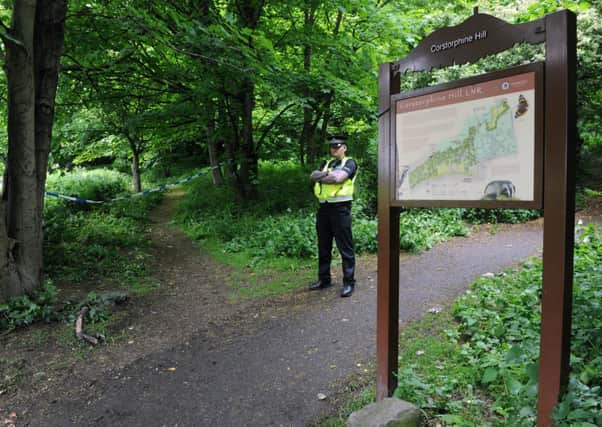Corstorphine Hill trial: ‘No emotion’ from accused


James Dunleavy, 40, answered “no comment” to most of the questions put to him during an hour-long interview. He also denied arguing with his mother Philomena Dunleavy, 66, who had come from her Dublin home to visit her son’s flat in Balgreen Road, Edinburgh.
The High Court in Edinburgh heard that the questions were put by Detective Constable Brian Manchester after Dunleavy was detained on 8 July as he left a shop near his home.
Advertisement
Hide AdAdvertisement
Hide AdA month earlier, the dismembered body of Mrs Dunleavy had been unearthed from a shallow grave on Corstorphine Hill – a 15-minute walk from the Balgreen Road flat.
After speaking to his solicitor in private, Dunleavy was questioned about his mother’s disappearance.
Detective Constable Manchester asked why, when Dunleavy had telephoned police five days earlier, had he spoken about his mother in the past tense when it had not been confirmed that she was dead.
“No comment,” replied Dunleavy.
Advocate depute Alex Prentice QC, prosecuting, asked the detective: “Throughout your dealings with Mr Dunleavy did he ever exhibit any emotion?”
Det Con Manchester told him: “No, not during the interview.”
The trial heard that Dunleavy also said he had not seen the photo reconstruction of his mother’s face which had been publicised in the media.
Professor Caroline Wilkinson, 48, of Dundee University – an expert in craniofacial identification – told how she was called in after police launched Operation Sandpiper to try to identify the mystery woman found on Corstorphine Hill.
She described how, beginning with computerised details of a skull, a picture of a face could be built up and features, such as hair, added with Photoshop.
Advertisement
Hide AdAdvertisement
Hide AdLucina Hackman, 44, also of Dundee University, who attended the post-mortem examination, described tell-tale marks which showed a saw had been used on Mrs Dunleavy’s thighs.
Ms Hackman, from the university’s centre for anatomy and human identification, said Mrs Dunleavy had probably been lying on her back and the saw cuts had been made from front to back and from left to right.
The trial earlier heard Mrs Dunleavy’s dismembered body had lain so long in a shallow grave that medics had difficulty working out how she died.
Pathologist Ian Wilkinson was asked if Mrs Dunleavy might have been alive but unconscious when a blade or saw was used on one of her legs.
The pathologist told the High Court that all the signs suggested it was most likely Mrs Dunleavy had been dead when she was beheaded and both her legs were severed at the top of the thigh.
The trial heard that 5ft 4in Mrs Dunleavy suffered from coronary heart disease and there were traces of drugs in her body - including morphine.
But there was also evidence of “blunt force trauma” to her head - although the skull was intact - tiny bones in her neck had been damaged and she had suffered a number of broken ribs.
Dr Wilkinson said the official conclusion was that the cause of death was “unascertained”.
Advertisement
Hide AdAdvertisement
Hide AdThe pathologist told defence QC Gordon Jackson: “Because of the condition in which the body was found a lot of our findings have to have caveats.
“Providing a conclusive cause of death was difficult in this case.”
Dr Wilkinson agreed with Mr Jackson that the injury to the neck bones might have been caused by someone gripping there while sawing off Mrs Dunleavy’s head. He also agreed that a broken bone in the shin could have happened during handling of the body.
The lawyer asked if injuries could have been the result of a fall. “That is indeed a possibility,” Dr Wilkinson told him.
He also agreed that after her death, someone else could have dismembered the body.
Dunleavy, 40, denies battering his mother to death between 30 April and 7 May last year.
He also denies attempting to defeat the ends of justice by trying to cover up the alleged murder and destroy evidence.
The trial at the High Court in Edinburgh continues.